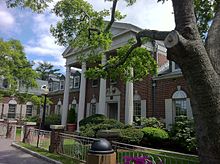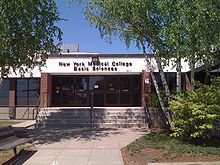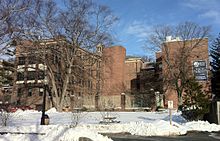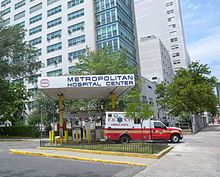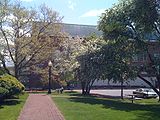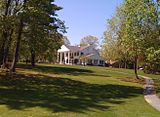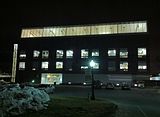- New York Medical College
-
New York Medical College 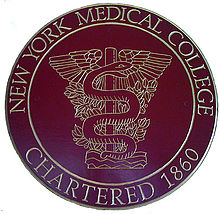
Motto Building on the excellence of our past Established 1860 Type Private Endowment $47.5 million[1] President Alan Kadish, MD Provost Ralph A. O’Connell, MD Academic staff 3,000[2] Students 1,660 (774 medical) Location Valhalla, New York Campus Suburban Colors Maroon, Ochre Mascot Canadian Goose (unofficial) Website www.nymc.edu New York Medical College, aka New York Med or NYMC, is a private graduate health sciences university based in Westchester County, New York, a suburb of New York City and a part of the New York Metropolitan Area. The university is located approximately 20 minutes by car north of Yankee Stadium and 35 minutes by express rail north of Grand Central Terminal/Times Square. The main campus in Valhalla includes Westchester Medical Center University Hospital, Maria Fareri Children’s Hospital, the Behavioral Health Center, and the Westchester Institute for Human Development. The second university hospital of New York Medical College is Metropolitan Hospital Center in Manhattan.
New York Medical College is the leading academic biomedical research institution between New York City and Albany, with $44 million in research and programs funded by the National Institutes of Health, corporations and other sources.[3] The university has specific strengths in the areas of cardiovascular disease, cancer, neuroscience and infectious disease.
Three schools comprise New York Medical College: the Graduate School of Basic Medical Sciences, the School of Health Sciences and Practice, and the School of Medicine. Total enrollment is 1,660 students (including 774 medical students), in addition to 800 residents and clinical fellows. NYMC employs 1,350 full-time faculty members and 1,450 part-time and voluntary faculty. The university has more than 12,000 alumni active in medical practice, healthcare administration, public health, teaching and research.
History of New York Medical College
New York Medical College owes its founding in 1860 to a group of civic leaders who believed that medical studies should be practiced with a better understanding of what the patient needs. This group of civic leaders was led by the noted poet William Cullen Bryant who was an editor of the New York Evening Post. Bryant was concerned about the condition of hospitals and medical education in New York City. His main concern was with some of the medical practices being used to treat disease, which at the time included bleedings, purges, and the administration of strong drugs in too large doses. Interest in the medical field rapidly grew over the next few years due to the United States Civil War, which generated a major need for health related occupations. As a result, the college was founded and opened as the Homeopathic Medical College of the State of New York on the corner of 20th Street and Third Avenue, near Union Square in Manhattan. In the first semester there were 59 students and 8 professors. The college adopted the name New York Homeopathic Medical College in 1869 and, in 1887, New York Homeopathic Medical College and Hospital.
A separate institution known as the New York Medical College for Women was founded a few years later in 1863. In 1867, it graduated Emily Stowe, the first female physician to practice in Canada. Three years later in 1870, Susan McKinney Stewart graduated as the first African-American female physician in New York State. When the Women's College closed in 1918, its students transferred to New York Medical College.
In 1875, Metropolitan Hospital Center opened as a municipal facility on Ward’s Island, staffed largely by the faculty of New York Medical College. As a university hospital of New York Medical College, this relationship is among the nation’s oldest continuing affiliations between a private medical school and a public hospital.
Built by New York Medical College in 1889, The Flower Free Surgical Hospital, was the first teaching hospital in the United States to be owned by a medical college. It was constructed at York Avenue and 63rd Street with funds given largely by Congressman Roswell P. Flower, later governor of New York. In 1908 the College changed its name to New York Homeopathic Medical College and Flower Hospital. In 1928 the College was the first medical school in the nation to establish a minority scholarship program. By 1935, the College had transferred its outpatient activities to the Fifth Avenue Hospital at Fifth Avenue and 106th Street. The College (including Flower Hospital) and Fifth Avenue Hospital merged in 1938 and became New York Medical College, Flower and Fifth Avenue Hospitals.
In 1972, New York Medical College opened a campus in Valhalla, at the invitation of the Westchester County government, which desired to build an academic medical center. Completed in 1977, Westchester Medical Center is currently the main academic medical center of the College. The College became affiliated with the Archdiocese of New York in 1978, which helped provide financial stability and also established a shared commitment for the public good in the area of health care and the health sciences. The College recognized itself in the Catholic tradition and remained affiliated with several Catholic hospitals. When Flower and Fifth Avenue Hospital closed in 1979, the main operations of New York Medical College were transferred to the Valhalla campus. The college shortened its name to New York Medical College in 1982.
In 1984, the New York State Department of Education recognized the status of New York Medical College as a university.
In December 2009, it was announced that Touro College in Manhattan had reached an agreement to assume the sponsorship role for New York Medical College from the Archdiocese of New York. New York Medical College officially joined the Touro College and University System on May 25, 2011 in a ceremony held at Bryant Park.
The Graduate School of Basic Medical Sciences
The College's involvement in graduate education dates back to 1910, when its records show the existence of advanced courses and research programs. Graduate courses in surgery and medicine were offered in the 1920s. In 1938, the College's charter was amended to include the authority to offer graduate degrees. In 1963, the Graduate School of Medical Sciences was officially founded, establishing for the first time a center for graduate education separate from the medical curriculum. The school was renamed the Graduate School of Basic Medical Sciences in 1969.
The GSBMS prepares future researchers, teachers, senior-level scientists and technicians to work in academia and industry. It is located in the Basic Sciences Building along with facilities of the School of Medicine. The graduate school has approximately 150 enrolled students and 90 faculty members.
Doctoral (PhD) and masters (MS) programs are available in the fields of cell biology & anatomy, biochemistry & molecular biology, pharmacology, pathology, physiology, and microbiology & immunology. The Graduate School offers an Accelerated Masters Program (AMP) intended for prospective medical school applicants and a MD/PhD dual degree program for current and prospective medical students.
The School of Health Sciences and Practice & Institute of Public Health
The School of Health Sciences and Practice began in 1981 as the Graduate School of Health Sciences, located at Vosburgh Pavilion near the School of Medicine and Westchester Medical Center. Student enrollment is approximately 500 with 221 faculty members (150 full-time).
The SHSP offers accredited programs in public health (MPH, DrPH), speech language pathology (MS), and doctor of physical therapy (DPT). Doctoral students may pursue a dual degree (MD/MPH) or joint degree (DPT/MPH) at significantly reduced cost.[4]
Students in the Master of Public Health program may major in Behavioral Sciences & Health Promotion, Epidemiology, Environmental Health Science, or Health Policy & Management
The School of Health Sciences and Practice also offers graduate certificates in the following areas: Global Health, Public Health, Certified Health Education Specialist (CHES-accredited), Industrial Hygiene, Management of Long-Term Care Facilities, Children with Special Health Care Needs (Center on Disability and Health), and Emergency Preparedness (Center for Disaster Medicine).
The School of Medicine
Founded in 1860, the School of Medicine at New York Medical College is one of the oldest in the nation. It is the largest of the three graduate schools, awarding approximately 190 Doctor of Medicine degrees per year. Students have the opportunity to earn joint degrees, combining the M.D. with a M.P.H., M.S. or PhD in the School of Health Sciences and Practice or Graduate School of Basic Medical Sciences
The School of Medicine has 774 actively enrolled students (31% in-state) along with 2,944 faculty members serving in 6 basic science and 20 clinical departments. Grading is Honors/High Pass/Pass/Fail. On-campus housing is provided for most preclinical students in furnished, unfurnished, single or married configurations.
In 2008, the passing rate for the USMLE Step 1 exam was 98%, above the 94% national average. To date, 13,270 physicians have graduated from the School of Medicine with 97% being board certified. Approximately 917 School of Medicine graduates currently serve on an American medical school faculty, including 18 department chairs.[5]
Affiliated Hospitals and Organizations
Located on campus, Westchester Medical Center University Hospital is the main academic medical center of New York Medical College School of Medicine, as well as the primary rotation site for medical students. It is ranked among the top five hospitals in New York State for bariatric surgery, and one of only 25 hospitals in the nation to receive the American Heart Association's 2008 Triple Performance Award. Westchester Medical Center also boasts the highest case mix index of all hospitals in the United States.[6]
Approximately half of the medical school class relocates to New York City for clinical rotations (MS-3, MS-4), for which the primary site is Metropolitan Hospital Center in Manhattan. Students are not officially assigned to a single location. Rather, they may trade individual rotations to best suit their needs. Housing is provided for rotations that are further from the main campus, such as those in Connecticut, New Jersey or Staten Island.
New York Medical College is affiliated with the following hospitals and health care organizations for graduate and undergraduate medical education: (* Designates trauma centers)
Westchester and upstate New York
- Westchester Medical Center (University Hospital) *
- Maria Fareri Children’s Hospital (University Hospital) *
- Benedictine Hospital
- Keller Army Community Hospital, West Point
- Phelps Memorial Hospital Center, Sleepy Hollow
- Mount Vernon Hospital
- Northern Westchester Hospital Center
- Saint Joseph's Medical Center, Yonkers
- St. Vincent's Hospital, Westchester
- Sound Shore Medical Center *
- VA Hudson Valley Health Care System
- Westchester Institute for Human Development
- Open Door Family Medical Centers
New York City
- Metropolitan Hospital Center (University Hospital) (Manhattan)
- Lenox Hill Hospital (Manhattan)
- New York Eye and Ear Infirmary (Manhattan)
- Terence Cardinal Cooke Health Care Center (Manhattan)
- Calvary Hospital (Bronx, Brooklyn)
- Center for Comprehensive Health Practice (Bronx)
- Montefiore Medical Center, North Division (Bronx)
- Richmond University Medical Center (Staten Island) *
Connecticut
New Jersey
- Hoboken University Medical Center
- St. Joseph's Regional Medical Center*
Matriculation and Residency Match
The School of Medicine is one of the more selective in the nation[citation needed], with an approximately 10% interview rate and 6% overall acceptance rate. Over 11,000 applicants from across the country applied for an entering class of 190 in the 2008–2009 application cycle, making New York Med the third most applied to medical school in the nation.[7][8]
Medical students are especially selected from the top colleges and universities across the country and the first-year class typically arrives with an average composite MCAT score of 31.[9][10] While the school's reputation among residency programs generally centers around the Northeastern United States, New York Med is a national medical school as 74.3% of the entering class and 83.0% of the applicants are from out of state.[7]
Matriculates in the class of 2010 graduated from 93 college and universities across the U.S and are residents of 27 states. Subsequently, the class of 2010 matched into the following specialties:[11]
- internal medicine (40)
- radiology (28)
- pediatrics (20)
- emergency medicine (18)
- anesthesiology (17)
- general surgery (16)
- orthopaedic surgery (10)
- psychiatry (10)
- Ob/Gyn (8)
- ophthalmology (5)
- physical medicine & rehabilitation (4)
- neurology (4)
- otorhinolaryngology (3)
- family practice (3)
- neurosurgery (1)
- pathology (1)
- medicine-pediatrics (1)
- child psychiatry (1)
- child neurology (1)
Notable alumni
- Michael J. Bronson, Co-Director of Joint Replacement Services at the Mount Sinai Medical Center[12]
- Susan McKinney Steward M.D. – first African-American female physician in New York State and third in the nation. Graduated in 1870, valedictorian of her class.[13]
- Emily Stowe M.D. – first female doctor to practice in Canada, and an activist for women's rights and suffrage.[13]
Images
Photos of New York Medical College The greater Grasslands Reservation contains New York Medical College, Westchester Medical Center, and several state and local agenciesOn-campus housing is available for most medical students and some graduate students.The Medical Education Center is distinguished by the prominent location of the gross anatomy laboratory (top floor)Basic Sciences Building and rear of Medical Education CenterAlumni HouseAdministrative, clinical, and graduate buildings: Munger Pavilion (left), Vosburgh Pavilion and School of Health Sciences and Practice (right)The Medical Education CenterThe Medical Education CenterReferences
- ^ As of June 30, 2009. "U.S. and Canadian Institutions Listed by Fiscal Year 2009 Endowment Market Value and Percentage Change in Endowment Market Value from FY 2008 to FY 2009" (PDF). 2009 NACUBO-Commonfund Study of Endowments. National Association of College and University Business Officers. http://www.nacubo.org/Documents/research/2009_NCSE_Public_Tables_Endowment_Market_Values.pdf. Retrieved February 20, 2010.
- ^ http://nymc.edu/AboutNYMC/
- ^ NYMC Student Handbook 2007–2010
- ^ http://www.nymc.edu/sph/department_programs.htm
- ^ NYMC Facts 2007 Brochure
- ^ [1]
- ^ a b http://www.aamc.org/data/facts/applicantmatriculant/start.htm
- ^ http://www.nymc.edu/OfficesAndServices/PublicRelations/Assets/feb10_InTouch.pdf
- ^ http://www.nymc.edu/Academics/SchoolOfMedicine/index.html
- ^ http://www.nymc.edu/Academics/SchoolOfMedicine/Admissions/FrequentlyAskedQuestions.html
- ^ NYMC Match List 2010
- ^ Michael O'Keeffe (December 11, 2007). "Local hospitals aid NFL retirees". New York Daily News. http://www.nydailynews.com/sports/football/2007/12/11/2007-12-11_local_hospitals_aid_nfl_retirees.html.
- ^ a b https://www.nymc.edu/Academics/SchoolOfMedicine/Admissions/MinorityAffairs.html
Colleges and Universities in Westchester County, New York Berkeley College • The College of New Rochelle • The College of Westchester • Concordia College • Fordham University • Iona College • Manhattanville College • Mercy College • Monroe College • New York Medical College • Pace University • St. Joseph's Seminary, Dunwoodie • Sarah Lawrence College • State University of New York at Purchase • Westchester Community CollegeCategories:- Universities and colleges in Westchester County, New York
- New York Medical College
- Schools of medicine in New York
- Schools of public health in the United States
- Middle States Association of Colleges and Schools
- Mount Pleasant, New York
Wikimedia Foundation. 2010.

